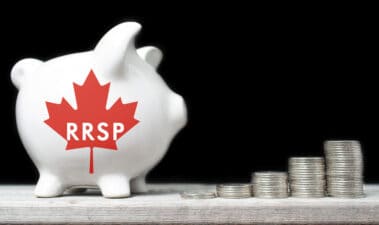What with a high-spending, fiscally lax federal budget and Trump-induced fears about tariffs and a global trade war, it’s little wonder Canadian investors are skittish and the loonie is taking a tumble.
The Canadian dollar (CAD) has fallen more than 5% since its 81.5 cent (in U.S dollars, or USD) peak on February 1, which means investors who have not diversified globally and into U.S. dollar-denominated investments are not getting the foreign currency boost they could have. Add to that continued underperformance of Canadian stocks relative to U.S. and even global markets, and you could argue that too much home-country bias constitutes a major headwind for domestic investors.
Certainly, Trump’s threatened 25% tariffs on imported steel and 10% on aluminum are potentially a near-term negative for Canadian exporters, as is the related threat of the NAFTA agreement being torn up. Still, none of these in themselves are a reason to head for the hills and hide in cash, even if interest rates are slowly inching up again. Remember that Trump is the author of The Art of the Deal, and it’s possible these threats of tariffs are merely an opening gambit in his negotiations. Odds are good that he may ultimately exempt Canada from the tariffs, while even if NAFTA dies, it’s likely that a bilateral trade agreement will be forged between the two countries.
So, I see no reason to make drastic changes to portfolio-asset allocation; panic is usually counterproductive, and sudden tactical shifts in asset mix predicated by the headlines is seldom a winning strategy. However, if you’ve losing sleep because you now perceive Canadian stocks to be a beleaguered asset class, it’s appropriate to revisit your asset allocation and regional and foreign currency exposure, or at least have a chat with your financial advisor.
Even without these threats, remember that Canada represents just over 3% of the global stock market; furthermore, two-thirds of the TSX’s market value is concentrated in just three sectors: financial, energy, and material.
But it’s what’s missing or barely represented that’s the real problem: the TSX has only a 3.5% weighting in technology, which is arguably the single biggest growth driver of the future. Any Canadian investor needs exposure to at least the U.S. market if they want a well-rounded portfolio that includes not just technology, but also industrials and defence stocks, a broader selection of consumer discretionary and consumer staples stocks, health care and pharmaceuticals, and other sectors that are underrepresented in Canada.
Recent articles have declared Canada is the worst-performing stock market in the world, or at least second worst behind Venezuela. Even so, the tax system (especially the rules governing non-registered portfolios) still tempts investors to have much more than 3% of their portfolios in Canadian stocks. If you intend to retire in Canada, it still makes sense to overweight Canadian equities and the CAD. But keep in mind that if your job and pensions are in CAD, as well as your home or business, you’ve got a lot riding on this country.
The real opportunity to diversify globally is in securities held in RRSPs, TFSAs, and non-registered investments. Once upon a time, RRSPs and pensions were constrained by the 20% and later the 30% foreign content limit, but that limitation no longer applies. Personally, I use the RRSP primarily for Canadian fixed-income and for U.S. dividend-paying stocks, or global equity ETFs trading on U.S. exchanges and denominated in the USD. TFSAs can hold Canadian dividend payers and non-dividend-paying foreign stocks, while non-registered investments can focus on Canadian dividends (benefiting from the dividend tax credit) and perhaps preferred shares, and also non-dividend-paying U.S. stocks.
I worry more about the long-term implications of the recent federal budget than Trump’s latest trade provocations. The budget of February 27, delivered by the Trudeau administration, pandered to every political voting block conceivable, except investors and business owners; it contained almost nothing that would encourage entrepreneurship or growth (save a modest retrenchment of what would have been harsh rules on small business passive income).
Gone is any attempt to balance the budget, and we’re far beyond the “modest” $10 billion yearly deficits that were bandied about when the Liberals first came to power. Bromides like “budgets balance themselves” hardly fill the electorate with confidence, and the budget’s failure to address this country’s tax competitiveness with America’s lowered tax regime is a major cause for alarm. The “tax it if it moves” mentality continues to dominate, and I fear that as the chickens come to roost for the next generation (which includes my daughter), that we will continue to see a top marginal tax rate that exceeds 50% in most provinces. That exorbitant (I almost misspelled it as extortionate!) level of taxation is the level likely to trigger an exodus of brains and capital.
As an investor seeking growth, I’d be looking to gradually increase exposure to the U.S., international, and emerging markets, using either USD-denominated ETFs or foreign ETFs that hedge back into the CAD; again, a chat with your advisor is necessary to determine the exact mix, depending on whether you intend to spend a lot of time in retirement in the U.S. or outside Canada.
A possible template for adjusting your foreign/domestic exposure might be the February 1st announcement by Vanguard Canada of three asset allocation ETFs, all trading on the TSX. VGRO [TSX] is 80% stocks and 20% fixed income, VBAL 60% stocks, and VCNS 40% stocks. All three use the same seven underlying ETFs but in different weights: the U.S., EAFE, and emerging markets equity exposure provides some currency diversification, while the U.S. and international bond exposure is hedged back into the CAD. Yes, Canada is still the single most represented geography in the ETFs, but they hold a lot more foreign content—especially foreign fixed income—than is normally held by those who succumb to home-country bias.
To me, VGRO is perfect for TFSAs, VBAL is for RRSPs for people with normal risk tolerance, and VCNS are for retirees or near retirees who need cash, as RRSPs morph to RRIFs and their annual (and taxable) withdrawals. They don’t seem perfect for non-registered accounts; however, again, I’d discuss the template of these products with an advisor and see how you could implement similar ideas across your portfolio.
Once achieved, with proper asset allocation, country diversification and currency diversification, you should be able to weather any storm that Donald Trump inflicts on global markets. As for Justin Trudeau’s budget, I wouldn’t look to Canadian stocks for growth for the foreseeable future; focus on solid dividend payers like the big banks, telecom and utility stocks, and perhaps REITs, with a healthy dollop of laddered two-year GICs while waiting for interest rates to rise.








